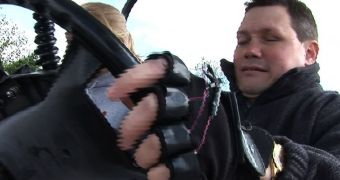The idea of a driving solution that will enable persons suffering from various vision deficiencies (including the total loss of eyesight) might seem to be futuristic and a bit far-fetched, but the truth of the matter is that it might actually be a whole lot closer than previously believed, given the fact that such a system has recently been demonstrated in the US by the National Federation of the Blind (NFB).
This solution was presented as a part of the NFB Blind Driver Challenge, and was demoed by Mark Anthony Riccobono, a blind executive who directs technology, research, and education programs for the NFB.
During the demonstration, Mr. Riccobono drove a Ford Escape hybrid equipped with nonvisual technology along 1.5 miles of the road course section of the famed track at the Daytona International Speedway, managing to not only take the several turns of the road course but also avoid obstacles, including stationary ones and even some of which were thrown into his path at random from a van driving in front of him (that he later successfully passed).
The non-visual technology mentioned above included laser range-finding sensors that conveyed information to a computer inside the vehicle, allowing it to create and constantly update a three-dimensional map of the road, and then transmit directions to vibrating gloves on the driver's hands, indicating which way to go, but also to vibrating strip placed on the driver's seat that indicated when to speed up, slow down, or stop.
After successfully completing the challenge, Mr. Riccobono said that "the NFB's leadership in the Blind Driver Challenge has taken something almost everyone believed was an impossible dream and turned it into reality. It was thrilling for me to be behind the wheel, but even more thrilling to hear the cheers from my blind brothers and sisters in the grandstands, today all of the members of the NFB helped drive us forward”.
“It is for them and for all blind Americans that the National Federation of the Blind undertook this project to show that blind people can do anything that our sighted friends and colleagues can do as long as we have access to information through nonvisual means. Today we have demonstrated that truth to the nation and the world," Mr. Riccobono concluded.
Of course, we're all eagerly looking forward for such systems to be safely implemented in consumer-grade automobiles, but it's quite likely that we'll have to wait a few more years before such vehicles become a reality.

 14 DAY TRIAL //
14 DAY TRIAL //